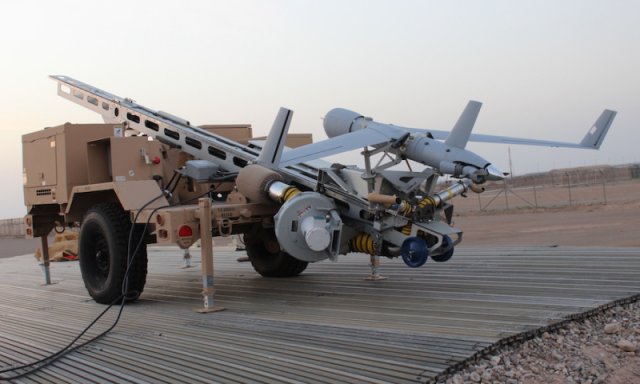Breaking news
Afghan Army's ScanEagle UAV made inaugural flight 22004164.
| a | |||
|
|
|||
|
Defence & Security News - Afghanistan
|
|||
|
|
|||
|
Afghan Army's ScanEagle UAV made inaugural flight
|
|||
|
The inaugural launch of a ScanEagle unmanned aerial vehicle in Helmand, Afghanistan marked new intelligence gathering capability for the Afghan National Defense and Security Forces. The Helmand ScanEagle site is the first of eight in Afghanistan that will be operational in the next two and a half years.
|
|||
|
|
|||
 An Afghan National Army's ScanEagle UAV An Afghan National Army's ScanEagle UAV(Credit: US Army) |
|||
|
|
|||
|
“The ScanEagle systems provide the Afghan National Army with airborne ISR [intelligence, surveillance and reconnaissance] capability, so they can see the battlefield from a different perspective,” said U.S. Army Maj. Jason White, deputy ScanEagle advisor, ISR Capabilities Integration Cell, Combined Security Transition Command-Afghanistan. “Before this technology, they relied on human and signals intelligence. The ScanEagle systems considerably increase their intelligence collection and reconnaissance ability.
“The Afghan National Army is now able to see enemy movements and can visualize enemy tactics,” added White, who hails from San Diego, California. “This technology helps them better prepare their troops.” Another ScanEagle system became operational this month at the training center in Mazar-e Sharif, where classroom training for future ScanEagle operators is conducted. Members of the Afghan National Army led construction at both sites. The 215th Engineering Kandak built the Helmand site, and in Mazar-e Sharif, the 209th Engineering Kandak renovated the classroom and the Afghan National Army Engineering School constructed the launch and recovery site. “The Afghan National Army was critical in building the ScanEagle facilities,” said U.S. Army Col. Thomas J. Tickner, director, CSTC-A Combined Joint-Engineer, of Wayne, Pennsylvania. “The engineering kandaks immediately stepped up to help their fellow soldiers by providing the necessary skills and materials to construct the sites.” “While coalition field service representatives are augmenting ScanEagle operations now, the Afghan National Army is expected to take over after the last class of initial trainees completes schooling in May 2018,” said U.S. Air Force Maj. Erin Tedesco, a Tampa, Florida native, who serves as lead ScanEagle advisor. Six months later, when the first class of Afghan National Army ScanEagle instructors complete their educational requirements, both training and operations will be completely manned by the Afghan National Army, added Tedesco. Afghan National Army 1st Lt. Sohrab Hakimi, of Faryab Province, attended a month-long training on ScanEagle in the United States in order to work with the systems. “We learned how to be a mission commander and how to use the data from the ScanEagle systems,” said Hakimi. “We studied how to work with the pilots, and trained on how to coordinate missions with air traffic controllers since we are responsible for tower clearance.” While only operating on the system for just over one week, Hakimi said that he has already seen benefits from implementation of the new surveillance system. “This technology is important for the Afghan National Army so we can better support troops on the ground,” said Hakimi. White and the ScanEagle field service representatives coordinate the area for surveillance with the mission commanders, including Hakimi, who work closely with the Afghan National Army intelligence cell. “Then we plan our flight route, clear the airspace and figure out logistics,” said White, adding that logistics included the timing of the mission and the amount of fuel needed in order to maximize flight efficiency. “ScanEagle is based on an autopilot system, so we program where it flies, and we can manually make edits if necessary.” White said the systems consist of two operational cameras; a daytime electro-optic camera with high-definition zoom capability. For nighttime operations, there is an infrared camera that is very sensitive to movement and heat. “The enemy also has a lot of activity at night and now we can see their movements,” said Afghan National Army Capt. Torab Ajiz, of Laghman Province, another mission commander. “After reviewing ScanEagle data we can plan a mission,” said Ajiz. “Then we are ready for our job and can take on the enemy.” |
|||



















